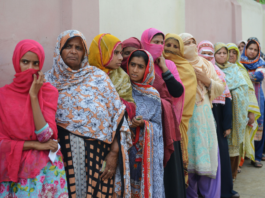
Balochistan has been shaken by large-scale protests once again. People are calling for political autonomy and protesting the Pakistan Army’s “kidnap, kill, and dump” strategy by holding demonstrations around the province. Large-scale protests have taken place throughout Balochistan since government employee Zaheer Baloch vanished in June this year.
Merely a handful of Baloch activists, like Mahrang Baloch, were autonomously covering the nonviolent demonstrations on social media.
Nonetheless, the majority of Pakistan’s leading media outlets and newspapers were hesitant or cautious in covering the protests.
On July 29, when security forces opened fire on Baloch protestors who had congregated in Gwadar, killing three and injuring numerous others, the protests captured the attention of the mainstream media.
Following this, a few prominent newspapers covered the altercations between protesters from Balochstan and the authorities.
Except for DAWN, which published an editorial by renowned journalist Zahid Hussain discussing the “growing alienation of the Baloch population, which has long been deprived of its fundamental rights,” no daily has published an editorial on the subject.
This lack of interest in the Balochis by the media is a symptom of a larger issue. The president of the Quetta Press Club, Shahzada Zulfiqar, said a few years ago that there is no journalism in Balochistan.
Balochistan is properly described as a “graveyard for journalists” by Amnesty International. Muhammad Siddiq Mengal, a prominent journalist and president of the Khuzdar Press Club, perished in a targeted bombing in the infamous Khuzdar district of Balochistan in May of this year.
He had already closed the press club six months prior in response to the death threats he had been receiving since 2023.
The killings began in 2005 when leaders of the Baloch people requested more autonomy from the government. When their demands were not met, a significant anti-state insurgent wave broke out.
When Chishti Mujahid, a reporter for the Urdu monthly Akhbar-e-Jehan, was slain by the Baloch Liberation Army (BLA) in 2008 for adopting an “anti-Baloch” and pro-Pakistan position in his articles, it marked the beginning of a string of targeted killings of journalists. There were other murders like this one.
Local journalists were warned against working with the Pakistan Army’s propaganda with, ISPR, by the Balochistan Liberation Front (BLF) in 2017.
Baloch militants persisted in kidnapping and killing important journalists throughout the course of the following few years who were connected to well-known media outlets like Geo TV, Pakistan TV, and Balochistan Times for crossing political boundaries.
Conversely, the state apparatus intimidated journalists who opposed the status quo and covered delicate subjects like as enforced disappearances and backed the Baloch cause.
A Khuzdar-based reporter claims that the majority of local journalists who wish to take on the authorities are underprivileged and helpless.
“Our bodies would be found the next day if we wrote about these things,” he lamented.
These reporters are frequently coerced, persuaded, and forced by the state to frame and edit news items in a way that advances their agenda.
Journalists incur several risks, yet they are not covered by insurance, and if they are killed or seriously injured, their families are not entitled to any recompense.
According to reports, in the recent turbulent history of Balochistan, the state authorities have only paid compensation to one journalist.
The state has been successful in instilling fear in the media community and discouraging unbiased reporting by refusing insurance benefits and privileges.
In Pakistan, the growing corporatization of the media is another unsettling trend. To pay for their expenses, all of the nation’s major media outlets mainly rely on advertising revenue.
Due to the lucrative business interests and potential for advertising, the majority of media networks are centered in the economically successful province of Punjab in Pakistan.
Conversely, Balochistan, a restive province, lacks the industrial and economic infrastructure necessary to draw advertising. Local newspapers have very little funding. In the districts of Balochistan, up to 90% of correspondents do not receive payment for their labor.
The reporters are underpaid and overworked because there is no “beat” structure in place. As a result, the few journalists who do show up for work are employed by a certain political party, armed organization, or intelligence service.
Due to power shortages, internet blackouts, and heightened surveillance, Balochis have not been able to fully utilize social media as a substitute venue for independent reporting. Truth is still at the whim of the powerful in the meantime.



